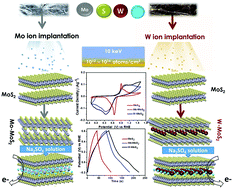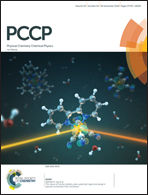Interrogating the effects of ion-implantation-induced defects on the energy storage properties of bulk molybdenum disulphide
Abstract
The effects of implanted molybdenum and tungsten ions on the energy-storage properties of electrodes made from bulk molybdenum disulphide (MoS2) have been investigated. Six samples of crystalline MoS2 were modified by an ion-implantation strategy: three samples with Mo ions and three with W ions, at varying fluences and at an energy of 10 keV. The Stopping and Range of Ions in Matter (SRIM) software was used to determine the simulated defect density in terms of vacancies and the implanted ion-penetration depth. Raman spectroscopy and photoluminescence spectroscopy were used to determine any changes in the material as a result of irradiation. Electrochemistry showed that the ion-implanted MoS2 samples exhibited significant energy storage properties (such as capacity, cycling stability, coulombic efficiency, and electron transfer kinetics) compared to the pristine MoS2 samples, confirming the effects of defects induced by ion-implantation.



 Please wait while we load your content...
Please wait while we load your content...